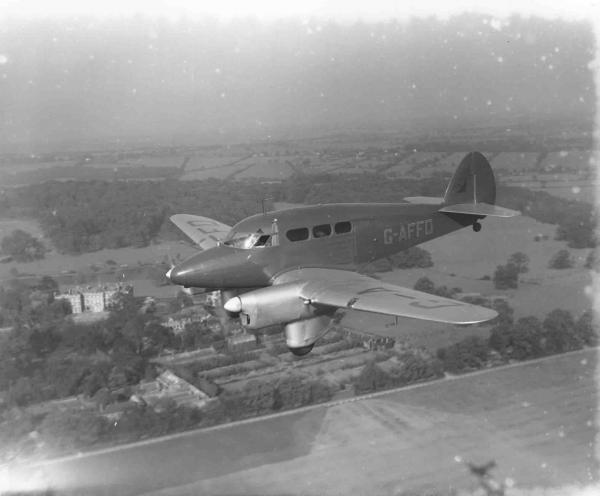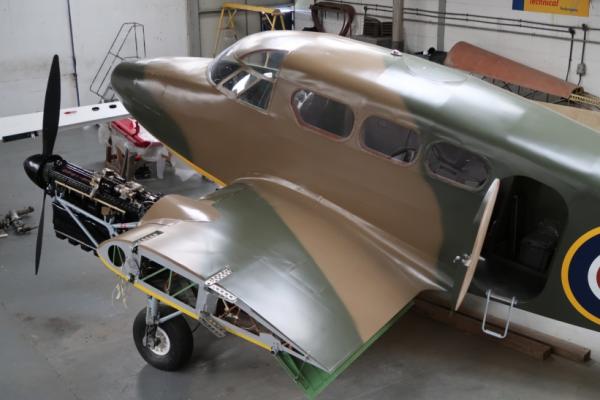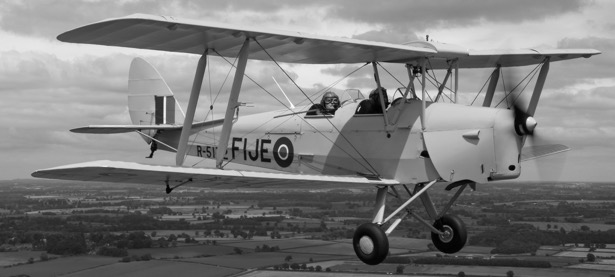
The Percival Q6 was designed as a fast yet economical twin-engined light transport for airline, charter and military duties although, from the outset, the aeroplane attracted private owners. Building on the experience gained with the classic Gull series of of single-engined touring and racing aircraft, the Q6 was constructed entirely of wood, sporting Percival split flaps and twin de havilland Gipsy Queen Six Series II engines driving de Havilland variable pitch propellors. Although the majority of the 27 Q6s built sport a fixed, faired undercarriage, retractable landing gear was offered as an option.
The Q6 was designed by Arthur Bage, whose contribution to the Q6 Handbook states that "the machine is very pleasant to fly" and that take off and general flying are 'normal'. However, he does warn that three point landings present difficulties to some pilots "owing to a falling off of the fore and aft control near the stall which is noticeable when a three point landing is attempted without engine from a glide approach". He also cautions against raising the flaps during the climb until 6-800' AGL. Our Q6 will be the subject of a formal test flying programme to produce the safest possible operating practices for this unique aeroplane.
 Above: Original advertisement for the Percival Q6 circa 1938.
Above: Original advertisement for the Percival Q6 circa 1938.
Edgar Percival made the first flight of the prototype Q6, G-AEYE, at Luton on 14 September 1937. Its speed and rate of climb were a massive improvement on the similarly-engined dH89a Dragon Rapide. Its closest competitor was the Mile M8 Peregrine, but the small Miles company was heavily committed to production of the Magister trainer for the RAF and was unable to put the Peregrine into production. The demise of the British Aircraft Manufacturing Company (BA) IV Double Eagle II had also left a gap in the market. 'Flight' magazine's October 27 1938 issue reported an early sales success for the Q6, with two sold to Lietuvos Oro Linijus (Lithuanian National Airlines); these aircraft were captured and impressed into Soviet Air Force service during 1940. The quoted price for a Q6 in 1939 was £4700.
Private owners included the King of Iraq and The Marquess of Londonderry, whose aircraft was impressed into RAF service and is one of two Q6s believed to have been lost during the Battle of France. The Rt Hon Viscount Forbes, British Air Attache in Bucharest from 31 October 1939 and later the head of RAF Intelligence in Athens, also took delivery of a Q6 in which he carried out a number of clandestine missions in Central Europe. Two examples were exported to India, serving with Tata Ltd and HEH The Nizam's State railway, Hyderabad. One example was purchased by the Australian Civil Air Board and was used for the carriage of Government ministers.
One Q6 was registered to Baron Leon Sternberg de Armella, fitted with Ratier variable pitch propellors and placed on the French register. Armella was a pre-war military pilot and reservist who was mobilized on the outbreak of war in 1939. Refusing the Armistice, he was demobilized in July 1940 and made his way to New York, where he joined the Free French Air Force under the name Bernard Duperier and travelled to England. Serving with 242, 615 and 340 (Free French) Squadrons as a fighter pilot, Duperier commanded 341 (Free French) Sqn and was Wing Leader at RAF Biggin Hill. His final tally was 7 enemy aircraft destroyed and 4 damaged. After parachuting into France to join the staff of General Keonig, commander of French Forces of the Interior, he was wounded during the operation to gain the surrender of German forces at Saint Brieuc. Post war, Duperier served as a member of the French parliament between 1962-1967; he died in 1995.
The RAF ordered a batch of Q6s and the remaining civilian examples were impressed into military service during 1940, serving with the RAF and the Royal Navy. The RAF employed the Q6 as a crew and VIP transport with 24 Sqn and its offshoot 510 Sqn, which later became the Metropolitan Communications Squadron and with 173 and 267 Sqns in Egypt. Two examples served with the the Egyptian Air Force. One of the Royal Navy aeroplanes was allotted to Flag Officer Carrier Training, which suggests there may be some truth in the rumour that a Q6 has been operated from an aircraft carrier!

G-AFFD in her most recent home - in the expert hands of restorer Rex Ford
Percival Q6 G-AFFD
G-AFFD was delivered to Sir Philip Sassoon, Under Secretary of State for Air, in Spring 1938. Sir Philip was Honorary Air Commodore of No 601 (County of London) Auxiliary Squadron; 'FD carried 601 Sqn's emblem of a winged sword on its fin and a coiled cobra mounted in front of the windscreen, as did all his aircraft. Sir Philip was a renowned social host and owned country houses at Port Lympe in Kent and Trent Park, near London. 'FD was based at Lympe and often flown by pilots of 2(AC) and 25 Squadrons, based at nearby RAF Hawkinge. Following Sir Philip's death on 3 June 1939. 'FD was sold and used for a while by the National Blood Transfusion Transport Service.
Impressed into RAF service on 4 April 1940 as X9407, the Aeroplane was allotted to no 6 Anti-Aircraft Co-Operation Unit at Ringway (now Manchester Airport). Following a period at 39 Maintenance Unit (MU), RAF Colerne, 'FD served with the Station Flights at RAF Heston, Halton and Old Sarum before joining 510 Sqn at RAF Hendon. Following a period at 5 MU, RAF Kemble, the Aeroplane's last stint of military duty was carried out with the Metropolitan Communications Squadron (as 510 Sqn had been renamed) at Hendon between January and April 1946.
Sold to the Yorkshire Aero Club as G-AIEY, once the Aeroplane's true identity was discovered, she was re-registered as G-AFFD. 'FD was transferred to Walter Instruments at Redhill in April 1952 and last flew (the short hop from Gatwick to Redhill) in 1955. Used as an instructional airframe at Chelsea College of Aeronautical Engineering at Redhill for many years, G-AFFD is being restored to airworthiness and will join the Finest Hour fleet once complete.
If anyone viewing this website can provide further details of her life, especially during the period 1938-1946, we would welcome contact.
All images copyright © Finest Hour Warbirds unless otherwise credited.

